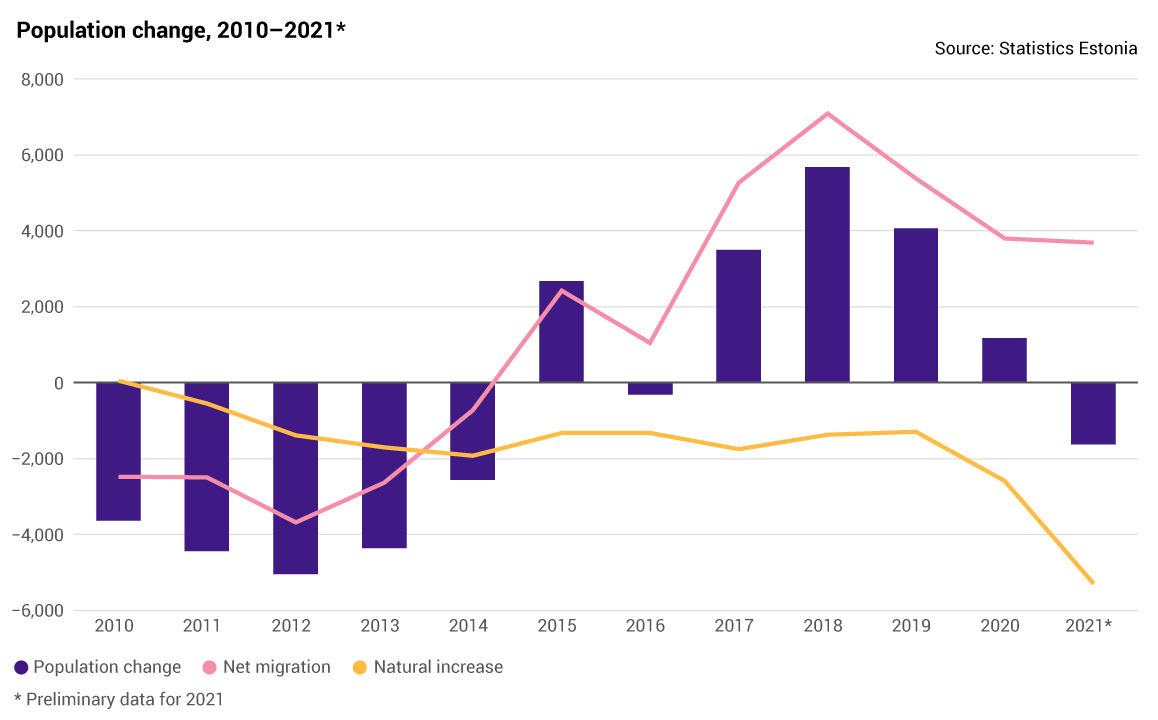The population of Estonia decreased, mainly due to the high number of deaths
According to the preliminary data of Statistics Estonia, on 1 January 2022, the population of Estonia was 1,328,439, which is 1,629 persons less than at the same time a year ago. In 2021, there were 13,138 births and 18,445 deaths in Estonia. Based on the data on registered migration, 12,280 persons immigrated to Estonia and 8,602 persons emigrated from Estonia.
Terje Trasberg, leading analyst at Statistics Estonia, said that last year stands out for an exceptionally high number of deaths, as there were 5,307 more deaths than births registered in 2021. “The high number of deaths combined with the number of births, which was similar to the level of recent years, meant that natural increase was negative. On the other hand, net migration was again positive – 3,678 more persons moved to Estonia than left for abroad. In the past, positive net migration has helped to boost the population figure, but in 2021 it was not enough and the population figure decreased.”
According to preliminary data, there were 18,445 deaths in Estonia in 2021, which is more than 2,500 deaths more than in the preceding year. “In the last ten years, the number of deaths has ranged between 15,000 and 16,000, and the difference from year to year has been around 300. Thus, the number of deaths recorded last year was extraordinary. We can analyse the causes of death more thoroughly in spring, when we receive detailed data. But it is safe to assume that the large number of deaths from coronavirus and the hot summer were among the key factors,” added Trasberg.
13,138 children were born last year, according to preliminary data – this number is similar to the number of births in 2020. Since the data are preliminary, there may be revisions.
According to the data on registered migration, in 2021, 12,280 persons immigrated to Estonia and 8,602 persons emigrated from Estonia. Compared to 2020, immigration increased by 1,890 persons and emigration by 1,282 persons. “The preliminary data indicate that, following the pandemic-related restrictions in force in 2020, there was a rise in both immigration and emigration levels last year,” noted Trasberg. She added that migration statistics are the most difficult to estimate based on preliminary data, as Statistics Estonia will later supplement migration data with population register data and data on unregistered migration.
Population figure through decades
A hundred years ago, in 1922, the population of Estonia was 1,097,733. The population figure was the highest in 1990, when it was 1,570,599. Over the last 20 years, the population of Estonia has been roughly 1.3 million.
In 2000, the population figure was adjusted based on census data. Although the population size is nowadays calculated using data from various registers, the census still plays an important role. “For example, the census results are used to determine the average age of women at first childbirth, the languages spoken as mother tongue in Estonia, the living conditions in our dwellings, and the size structure of households,” explained Trasberg. There is a population census in progress now. For this census, Statistics Estonia collects most of the data from registers, but there is additionally a short e-questionnaire that all residents aged 15 and above can fill in online at rahvaloendus.ee.
The preliminary population number is based on the initial data on births, deaths and registered migration of the previous year. Statistics Estonia will publish the revised population figure with revised vital events (migration, births and deaths) on 12 May.
More detailed data have been published in the statistical database.
See also the population section on our website.
For further information:
Kadri Kütt
Media Relations Manager
Marketing and Dissemination Department
Statistics Estonia
Tel +372 625 9181
